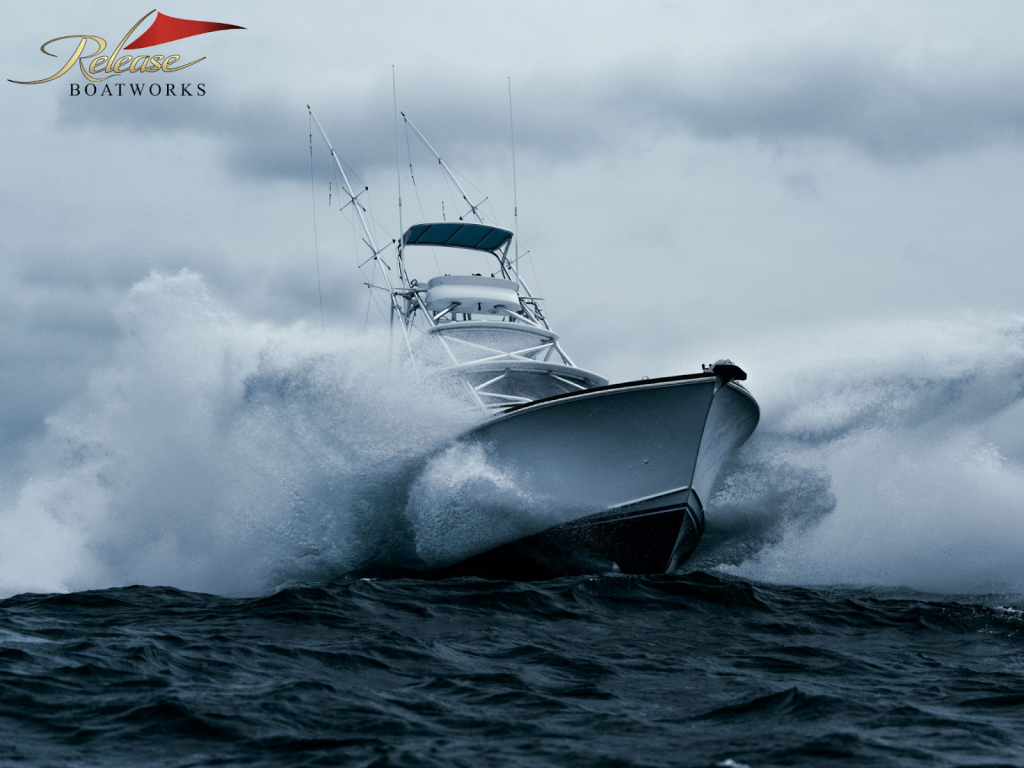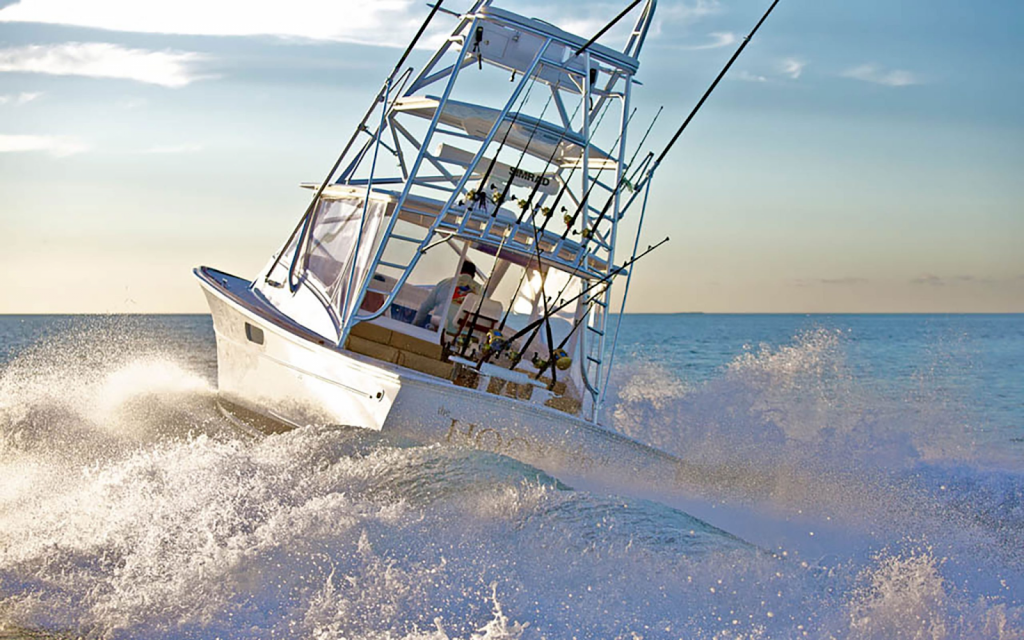Release sportfish boats are built using advanced composite materials like fiberglass paired with vacuum-infused modified-epoxy resin for offshore strength and reliability.
More broadly, sportfishing boats across the industry are made from a wide range of materials, from traditional wood and polyester resin to modern composites and epoxy systems, each with trade-offs in durability, weight, and maintenance.
Before evaluating a sportfish by its profile or price, start with what’s beneath the paint. These are the material and build choices that define a capable offshore boat:
- Fiberglass remains the industry benchmark for strength and corrosion resistance
- Vacuum-infused modified-epoxy resins create void-free, high-integrity hulls
- Carbon fiber and Kevlar provide localized stiffness and impact protection where needed
- Foam-encapsulated composite stringers help eliminate rot and reduce vibration
- Construction materials directly impact ride comfort, efficiency, and longevity
At Release Boatworks, we use proven materials and construction methods for performance. From vacuum-infused modified-epoxy hulls and stringers and a fully composite bulkhead system, every choice we make supports strength, fishability, and long-term durability.
Keep reading to see why the materials inside your hull matter as much as the gear on deck, and how the right foundation can turn a good trip into a great one.
Common Materials Used in Sportfishing Boats

From garage projects to seven-figure customs, the materials used in sportfish boats vary widely, and so do their results offshore. Every choice, from fiberglass to carbon fiber, brings tradeoffs in strength, maintenance, performance, and longevity.
Understanding what’s inside your hull is the first step in telling the difference between a dockside cruiser and a boat built for bluewater.
Fiberglass (The Industry Standard)
Fiberglass remains the most widely used material in sportfish boat construction for good reason. It’s durable, corrosion-resistant, and well-suited to saltwater environments. When laid with multi-axial glass and paired with high-performance resins, it delivers dependable structure and ride quality.
But fiberglass isn’t all built the same. Many production builders rely on polyester resins and chopper gun layups to save time and cost. We don’t. Our hulls are vacuum-infused using biaxial and triaxial fiberglass cloths and epoxy-based resin systems, engineered for strength, consistency, and offshore punishment.
Looking at a Release 36 Express or 55 Walkaround? That’s fiberglass done right, built for offshore performance, not shortcuts.
Wood (Old School, With Caveats)
Cold-molded wood has a nostalgic reputation and can deliver a smooth ride. But it requires constant attention. Wood adds weight, invites rot, and complicates long-term ownership.
Some builders use it for tradition’s sake, but at Release, we don’t use wood anywhere in the structure. When performance and reliability are non-negotiable, composites win every time.
Modern Construction Techniques That Make a Difference
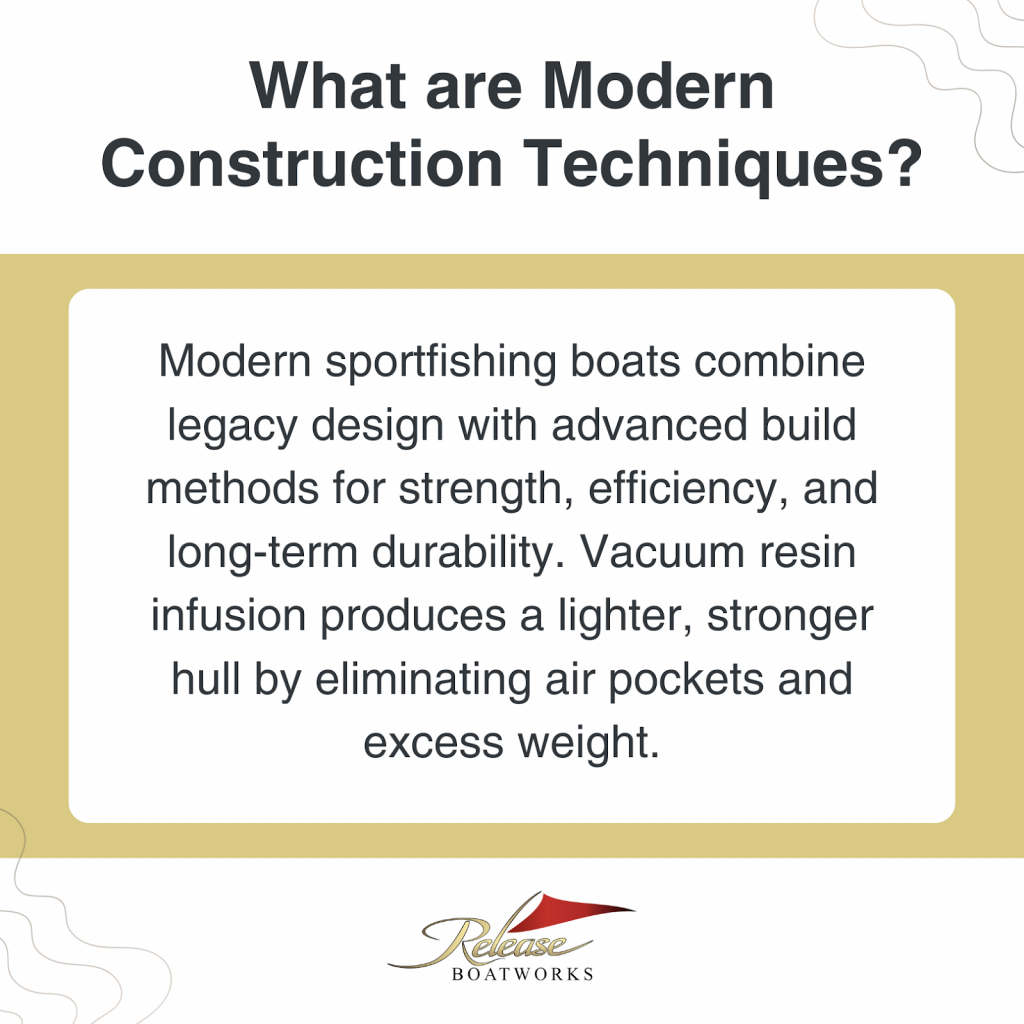
Materials are only part of the equation; how they’re applied defines a sportfish boat’s longevity, rigidity, and performance offshore. The strongest custom boats combine time-tested layouts with advanced construction processes that hold up in the real world, not just on paper.
Resin Infusion
Vacuum resin infusion remains the benchmark for offshore hull construction. This process draws resin evenly through fiberglass under vacuum pressure, removing voids and excess resin. The outcome is a consistent, high-strength laminate with excellent fatigue resistance and dimensional stability.
Every Release hull, from the 36 Express to the 55 Gameboat, is built using vacuum-infused, modified epoxy resin. It’s a more demanding method, but one that pays off in sharper handling, quieter runs, and structural confidence in bluewater.
Vacuum-Infused Foam-Encapsulated Stringers
Rather than using wood cores or secondary bonds, we engineer our hulls with foam-encapsulated stringers, fully infused with the hull to form an integrated structural grid. This enhances hull stiffness, controls vibration, and eliminates concerns about water intrusion or rot.
That grid structure supports the hull, spreads impact loads from towers, chairs, and gear, and gives our boats their battle-ready durability. It’s one reason our boats maintain integrity even after hundreds of hours offshore.
Cold Molding
Some traditional builders still use cold molding, layering thin wood veneers with epoxy, to create hulls with a classic ride. While visually impressive, this technique requires ongoing upkeep and doesn’t offer the same long-term durability or maintenance advantages as infused composites.
At Release, we respect the heritage, but we’ve moved beyond it. Our process is built around zero-wood structures and proven materials that deliver reliability where it counts.
Custom vs Production: Material Choices You Control (and Don’t)
Not all “custom” claims are created equal. In the sportfish world, the real difference between a production hull and a true custom build comes down to control, particularly over materials and structure.
Buying off the shelf means inheriting someone else’s compromises. Building with us means every inch is shaped around your program.
Production boats often rely on cost-driven materials like polyester resin and pre-set mold designs. While they may offer cosmetic upgrades, the structural bones are locked in.
That’s why many production boats look sharp dockside but fall short when the conditions turn rough offshore.
Our process starts with the owner, serious fishermen, and our build team aligned from day one. From resin selection to hull laminate schedules, every Release, from the 43 Walkaround to the 66 Flybridge-Walkaround, is crafted for real-world use.
We don’t believe in surface-level upgrades. You define the layout, structure, systems, and fishability.
How Materials Impact Performance, Ride, and Fishability
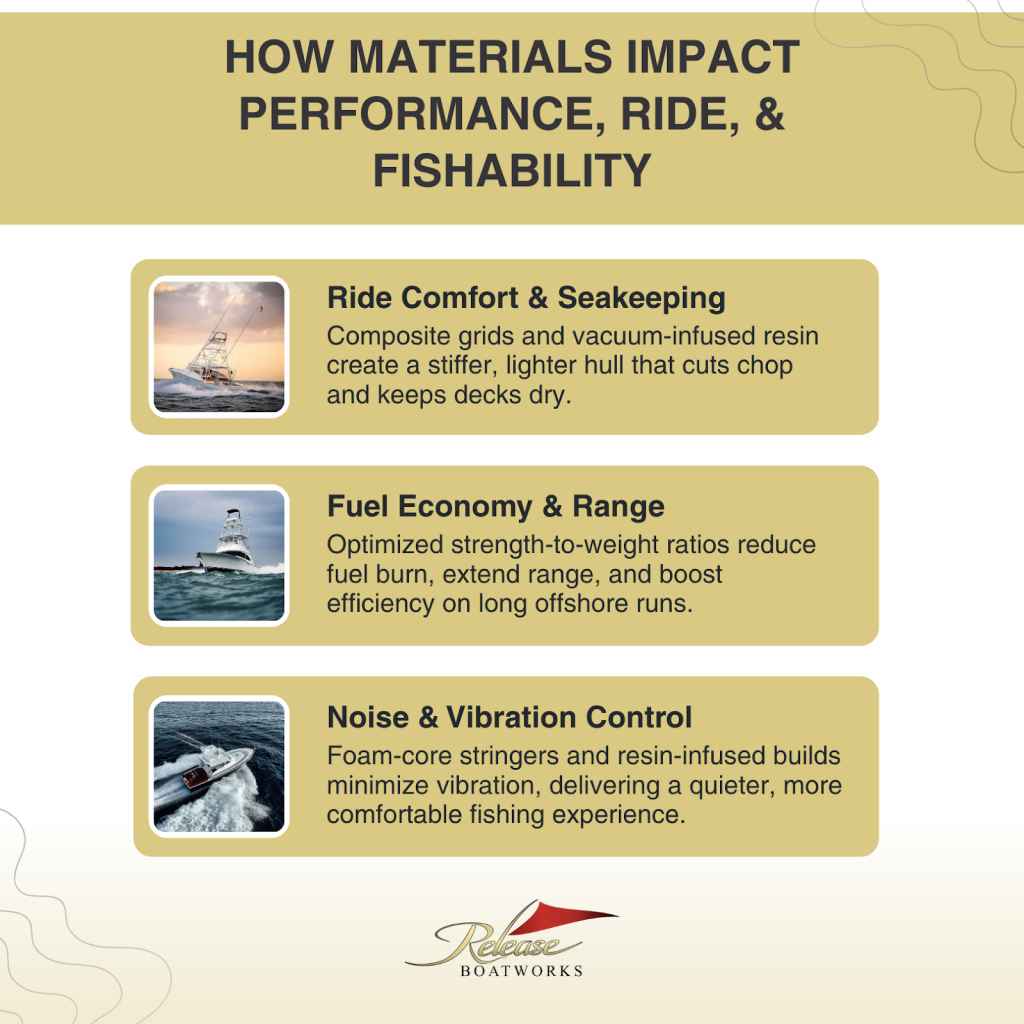
Every construction decision becomes obvious once the boat hits open water. The choice of core materials, resins, and structural layout determines how a sportfish boat handles, performs, and holds up during extended offshore runs. This is where design choices translate directly into capability.
Ride Comfort & Seakeeping
A stiffer hull built with vacuum-infused resin and composite grids slices through chop and resists flex under load. Combined with elements like a Carolina flare and proud bow, it keeps spray down and the ride clean. It’s a difference you can feel the moment the bow breaks through a head sea.
Fuel Economy & Range
Strength-to-weight balance plays a major role in fuel efficiency. When hulls are properly engineered, they require less power to reach the plane and stay on it, especially on long runs out to 80 or 100 miles. Our designs prioritize performance without excess, giving you more range and fewer interruptions.
That’s why models like the 43 Gameboat cruise efficiently at 30 knots while remaining agile and responsive. Built to pursue fish, not push unnecessary bulk.
Noise & Vibration Control
Foam-core stringer grids and vacuum-infused construction reduce hull flex, engine harmonics, and structural rattle. The result is a quieter platform with less fatigue for anglers, electronics, and gear. Whether underway or trolling, clean acoustic profiles help keep attention on the spread.
Maintenance, Repairability, and Long-Term Ownership
A sportfish boat earns its reputation offshore, but only when it’s built to last. Material and construction choices directly impact how often repairs are needed, how straightforward they are to complete, and how well the hull holds up over the long haul. The smarter the choices, the fewer issues later.
Fiberglass paired with modified-epoxy or vinyl ester resins outperforms polyester layups by resisting blistering, delamination, and fatigue. Fully composite structures eliminate rot concerns, particularly when foam-encapsulated stringers replace wood.
This type of build holds its shape under pressure and requires fewer maintenance cycles over its life.
Some buyers have asked whether foam-cored stringers flex under load. The answer lies in execution. In our builds, stringers are built with the hull using vacuum resin infusion and multi-axial glass, creating a monolithic structure. The result is a rigid, stable platform with none of the water intrusion risks associated with traditional wood cores.
When it’s time for upgrades or structural work, composite hulls with clean lamination are easier and faster to service than mixed-material or cold-molded boats. That translates to more time fishing and less time on the hard.
Myths & Misconceptions About Sportfish Construction
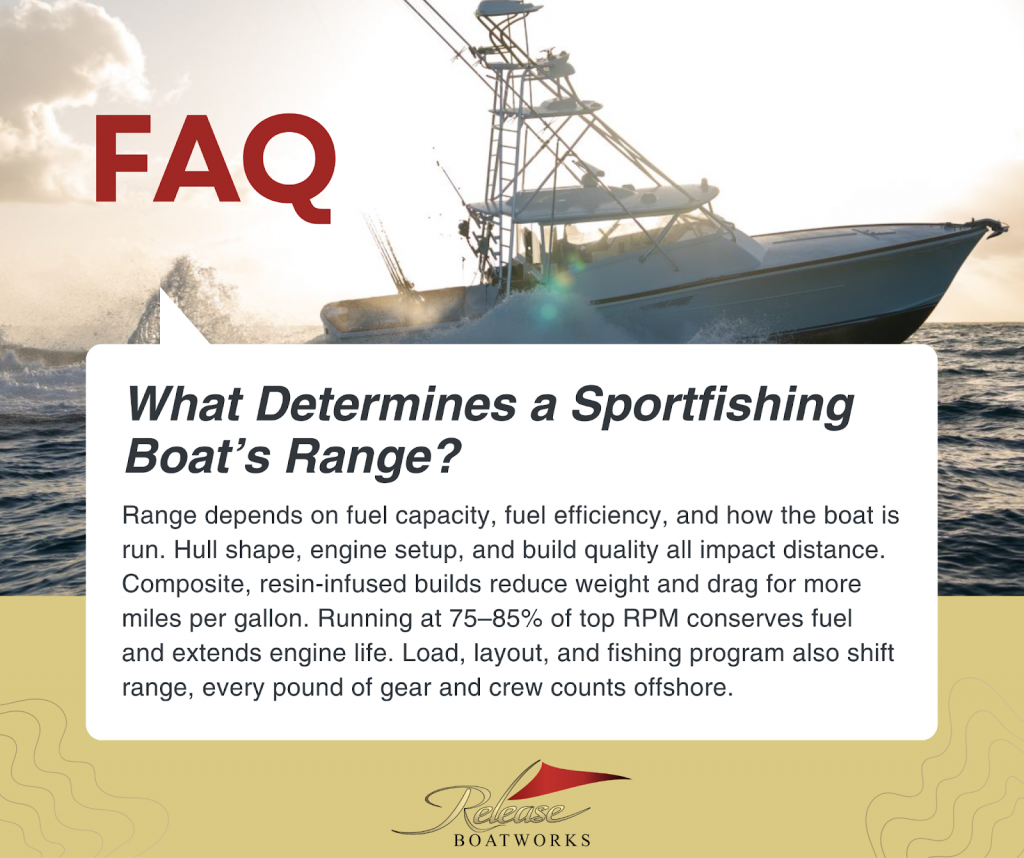
Spend time at the dock or scroll through forums, and you’ll find plenty of misconceptions about what makes a capable sportfishing boat. Many of these myths stem from comparing spec sheets instead of time on the water. Here’s what we hear, and how it plays out offshore.
Bigger is always better.
Not when it comes at the cost of manageability. Larger boats offer extended range and more amenities, but for serious owner-operators, the right size paired with capability often outperforms raw scale. The 46 Walkaround was built for this exact balance.
You can buy your dream boat off the shelf.
Production builders might offer cosmetic choices, but structural customization, deck layout, systems integration, and helm configuration require a true custom build. That’s where Release starts: around how you fish, not how a brochure looks.
Custom means high maintenance.
Only if the wrong materials or methods are used. Our builds rely on vacuum-infused composites, epoxy resins, and a fully wood-free structure. The result is less rot risk, fewer soft spots, and a longer life with lower upkeep. Smart design means more fishable days.
These are toys for rich guys.
Our boats are built for performance, not for show. The owners we serve prioritize reliability, clean layouts, and offshore capability that holds up to serious use. They’re tools, built for the bite.
What Makes Our Builds Different
There’s a reason our hulls don’t just look right, they run right. Every decision we make, from resin selection to stringer configuration, reflects one core belief: offshore performance is the only measure that matters. If a boat can’t hold up where it counts, it doesn’t belong in our lineup.
We avoid shortcuts, no wood cores, no rushed schedules, no trend chasing. Instead, we use vacuum-infused modified epoxy resin, composite grid structures, and engineered laminates developed with naval architect Erwin Gerards.
From the 36 Walkaround to the 66 Gameboat, every model is built for long-term durability, owner usability, and tournament-grade capability.
This isn’t just construction. It’s a commitment. Whether you’re moving up from production or commissioning your first true custom, you’re not buying a status symbol; you’re building a purpose-driven machine. One made to run hard, fight clean, and stay tight through every mile.
Ready to Build a Better Boat?

Understanding what goes into your sportfish build is more than trivia. It’s the foundation of lasting performance. The right materials and construction methods create stronger hulls, better rides, and longer service life. For offshore programs, those decisions matter.
We build one boat at a time, each tailored to how you fish, where you go, and what your days offshore demand. If you’re ready to start the build process or want to talk about layout and systems, reach out. We’ll walk you through every step, because that’s how legacies are built.‘
FAQ
When anglers get serious about construction, they start asking the right questions. Here are a few we’ve heard, answered straight from the build team.
Can you retrofit a fiberglass hull to improve offshore performance?
It depends on the extent of the changes. While minor reinforcements or layout tweaks can help, the biggest performance advantages come from materials and methods integrated during the original build, like vacuum infusion, composite grids, and smart core selection. That’s why we believe in getting it right from the start.
How do hull materials affect sonar and transducer performance?
Composite hulls support cleaner through-hull transducer installations and help maintain signal clarity. In contrast, aluminum can interfere with sonar signals. We take placement seriously, bonding transducers properly to support deepwater setups.
Do hull materials impact resale value?
Without question. Boats built with vacuum-infused composite hulls and no wood maintain higher long-term value. Buyers recognize the reduced maintenance risk and structural integrity, especially when the boat has been fished hard and maintained properly.
What are the trade-offs between a heavy and light build offshore?
Heavier boats may feel stable at rest but tend to push inefficiently through chop. Properly balanced, lighter designs, like our 55 Express, plane quickly, ride dry, and handle with precision. The goal isn’t to chase a weight number; it’s to engineer balance, strength, and performance together.


